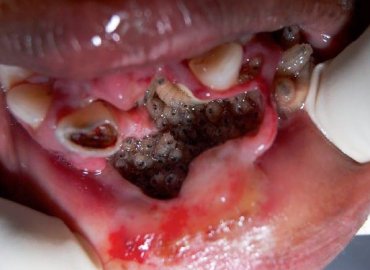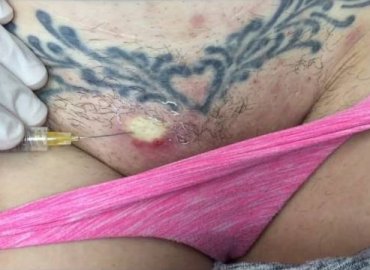An abscess is a painful collection of pus, usually caused by a bacterial infection. Abscesses can develop anywhere in the body.
Symptoms of an abscess
A skin abscess often appears as a swollen, pus-filled lump under the surface of the skin. You may also have other symptoms of an infection, such as a high temperature (fever) and chills.
It’s more difficult to identify an abscess inside the body, but signs include:
- pain in the affected area
- a high temperature
- generally feeling unwell
- Causes of abscesses
Most abscesses are caused by a bacterial infection.
When bacteria enter your body, your immune system sends infection-fighting white blood cells to the affected area.
As the white blood cells attack the bacteria, some nearby tissue dies, creating a hole which then fills with pus to form an abscess. The pus contains a mixture of dead tissue, white blood cells and bacteria.
Internal abscesses often develop as a complication of an existing condition, such as an infection elsewhere in your body. For example, if your appendix bursts as a result of appendicitis, bacteria can spread inside your tummy (abdomen) and cause an abscess to form.
Abscesses can be treated in a number of different ways, depending on the type of abscess and how large it is.
The main treatment options include:
- antibiotics
- a drainage procedure
- surgery
- Skin abscesses
Some small skin abscesses may drain naturally and get better without the need for treatment. Applying heat in the form of a warm compress, such as a warm flannel, may help reduce any swelling and speed up healing.
However, the flannel should be thoroughly washed afterwards and not used by other people, to avoid spreading the infection.
For larger or persistent skin abscesses, your GP may prescribe a course of antibiotics to help clear the infection and prevent it from spreading.
Sometimes, especially with recurrent infections, you may need to wash off all the bacteria from your body to prevent re-infection (decolonisation). This can be done using antiseptic soap for most of your body and an antibiotic cream for the inside of your nose.
However, antibiotics alone may not be enough to clear a skin abscess, and the pus may need to be drained to clear the infection. If a skin abscess isn’t drained, it may continue to grow and fill with pus until it bursts, which can be very painful and can cause the infection to spread or recur.
Incision and drainage
If your skin abscess needs draining, you’ll probably have a small operation carried out under anaesthetic – usually a local anaesthetic, where you remain awake and the area around the abscess is numbed.
During the procedure, the surgeon makes a cut (incision) in the abscess, to allow the pus to drain out. They may also take a sample of pus for testing.
Once all of the pus has been removed, the surgeon will clean the hole that is left by the abscess using sterile saline (a salt solution).
The abscess will be left open but covered with a wound dressing, so if any more pus is produced it can drain away easily. If the abscess is deep, an antiseptic dressing (gauze wick) may be placed inside the wound to keep it open.
The procedure may leave a small scar.
Internal abscesses
The pus usually needs to be drained from an internal abscess, either by using a needle inserted through the skin (percutaneous abscess drainage) or with surgery.
The method used will depend on the size of your abscess and where it is in your body.
Antibiotics will usually be given at the same time, to help kill the infection and prevent it spreading. These may be given as tablets or directly into a vein (intravenously).
Percutaneous drainage
If the internal abscess is small, your surgeon may be able to drain it using a fine needle. Depending on the location of the abscess, this may be carried out using either a local or general anaesthetic.
The surgeon may use ultrasound scans or computerised tomography (CT) scans to help guide the needle into the right place.
Once the abscess has been located, the surgeon drains the pus using the needle. They may make a small incision in your skin over the abscess, then insert a thin plastic tube called a drainage catheter into it.
The catheter allows the pus to drain out into a bag and may have to be left in place for up to a week.
This procedure may be carried out as a day case procedure, which means you’ll be able to go home the same day, although some people will need to stay in hospital for a few days.
As with the incision and drainage procedure for skin abscesses, percutaneous drainage may leave a small scar.
Surgery
You may need to undergo surgery if:
your internal abscess is too large to be drained with a needle
a needle can’t get to the abscess safely
needle drainage hasn’t been effective in removing all of the pus
The type of surgery you have will depend on the type of internal abscess you have and where it is in your body. Generally, it involves making a larger incision in your skin to allow the pus to be washed out.







